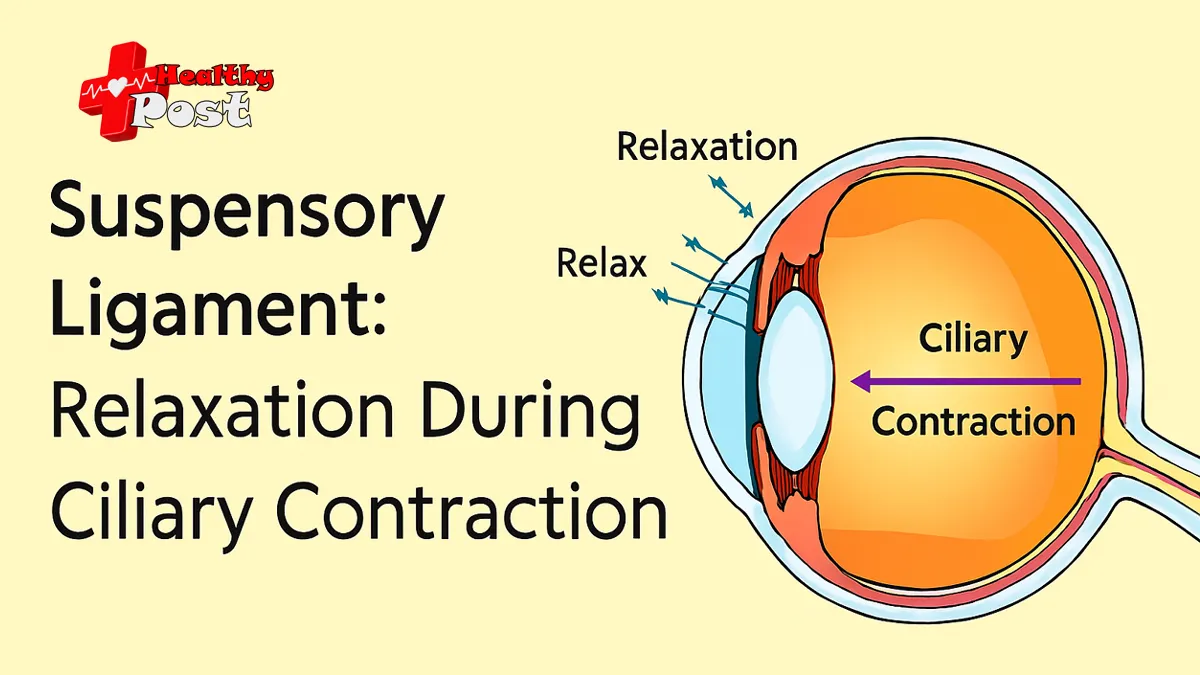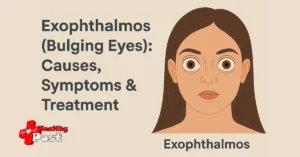
Why does the suspensory ligament relax when the ciliary body contracts?
If you’ve ever wondered how your eyes instantly shift focus from a distant mountain to a text message, you’re in the right place. In the simplest terms, your eye changes focus through a finely tuned team effort between the ciliary body, the lens, and the fibers that connect them—known as the suspensory ligaments. Understanding this process doesn’t have to be complicated. In fact, once you visualize how these structures work together, the big question—why the suspensory ligament relaxes when the ciliary body contracts—becomes surprisingly intuitive.
Right up front: the suspensory ligaments are a ring of tiny fibers that hold your lens in place. When the ciliary body contracts, it slackens these fibers, letting the lens naturally round up for near vision. That’s the core mechanism, and it’s both elegant and essential. Let’s break it down in a friendly, relatable way—with real-life examples, practical tips, and a few visual aids to keep things clear.
Quick Snapshot: What Are We Talking About?
- Suspensory ligaments: Tiny fibers (also called zonules) that connect the ciliary body to the lens capsule.
- Ciliary body: A circular muscle around the lens that changes tension on those ligaments.
- Lens: A flexible, clear structure that changes shape to focus light on the retina.
- Goal: Crisp vision at different distances through a process called accommodation.
The Short Answer (With a Simple Visual in Mind)
Imagine a drawstring around a soft water balloon (the lens). When the drawstring (suspensory ligaments) is pulled tight, the balloon flattens. When you loosen the drawstring by tightening the ring it’s attached to (the ciliary body), the balloon springs back to a rounder shape.
That’s your eye during accommodation:
- Ciliary body contracts → ring diameter decreases.
- Suspensory ligaments relax → less pull on the lens.
- Lens bulges (becomes more curved) → better for near focus.
This is the mainstream “Helmholtz theory” of accommodation and it has stood the test of time for over a century.
Why Do Suspensory Ligaments Relax When the Ciliary Body Contracts?
Let’s make this intuitive without jargon:
- The ciliary body forms a circular ring around the lens.
- When you look at something up close, the ciliary muscle contracts like a tightening belt, reducing the diameter of that ring.
- Because the ring is now smaller, the fibers (suspensory ligaments) connecting the ring to the lens are no longer being stretched tight—they slacken.
- The lens, which is naturally elastic, springs into a rounder shape.
- A rounder lens bends light more strongly, letting you focus on nearby objects.
Think of it like loosening a trampoline: if you bring the frame inward, the springs (ligaments) aren’t stretched as much, and the surface (lens) can dome upward.
A Step-by-Step View: Far vs. Near Focus
- Looking far away:
- Ciliary body is relaxed.
- Ring diameter is larger.
- Suspensory ligaments are taut.
- Lens is flatter (less curved).
- Result: Focuses distant objects sharply.
- Looking up close (like reading your phone):
- Ciliary body contracts.
- Ring diameter shrinks.
- Suspensory ligaments relax.
- Lens gets rounder (more curved).
- Result: Focuses near objects clearly.
Visual Aid: Near vs. Distance Focusing at a Glance
| Feature | Distance Focus (Far) | Near Focus (Accommodation) |
|---|---|---|
| Ciliary body | Relaxed | Contracted |
| Ring diameter | Larger | Smaller |
| Suspensory ligaments (zonules) | Taut (more tension) | Relaxed (less tension) |
| Lens shape | Flatter (less curved) | Rounder (more curved) |
| Optical power | Lower | Higher |
| Typical pupil response | Slightly larger | Slightly constricted (near triad) |
| Best for | Distant objects | Reading, phone, close work |
This table is worth saving—especially if you’re a student, content creator, or someone optimizing educational content with Rank Math SEO.
What Exactly Are the Suspensory Ligaments (Eye)?
The suspensory ligaments eye system—also called the zonular fibers or Zonules of Zinn—are incredibly fine, transparent fibers arranged like spokes of a wheel. They attach the outer capsule of the lens to the ciliary body. Their job is to transmit the tug-of-war between the ciliary muscle and the lens. They don’t move the lens by themselves; instead, they vary the tension on the lens capsule, allowing the lens to change shape.
A few simple facts:
- They are resilient but delicate.
- Their arrangement is three-dimensional, not just a simple ring.
- Their integrity matters: if these fibers are weak (as in some genetic conditions), the lens may shift position (ectopia lentis), affecting focus.
The Lens: Naturally Springy and Ready to Round
The lens is like a soft, clear cushion. It wants to be rounder by default because of its elastic capsule and internal structure. When the suspensory ligaments pull tight (for distance vision), they “flatten” that cushion. When those ligaments relax (thanks to ciliary muscle contraction), the lens happily rebounds to a more curved shape perfect for near tasks.
This “default to rounder” property is crucial. Without that natural elasticity, there would be nothing for the relaxed ligaments to reveal. That’s why, as we age and the lens stiffens (presbyopia), near focusing becomes harder—even if the ciliary muscle is doing its best.
Benefits of Understanding This Mechanism
Grasping how the ciliary body and suspensory ligaments work together isn’t just trivia—it can improve your daily comfort, guide smarter habits, and help you talk with your eye care professional more confidently.
1) Better Near-Work Comfort and Less Eye Strain
- Knowing that near focus demands ciliary muscle effort reminds you to take regular breaks.
- The 20-20-20 rule (every 20 minutes, look at something 20 feet away for 20 seconds) gives the suspensory ligaments a chance to retighten and the ciliary muscle to relax.
- Real-life example: If your eyes feel tired after spreadsheets or scrolling, a two-minute “distance gaze” on the horizon can ease that tight, inside-the-eyeball feeling.
2) Smarter Screen and Reading Habits
- Slightly larger text, good lighting, and appropriate screen distance reduce the need for intense accommodation.
- Holding your phone 14–16 inches away, instead of 8–10 inches, can make a noticeable difference.
- A monitor at arm’s length with top-of-screen at or slightly below eye level relaxes your focusing system and your neck.
3) Early Clues About Presbyopia (Age-Related Near Blur)
- Around your 40s and 50s, the lens stiffens and doesn’t round up as easily even when the suspensory ligaments relax.
- Symptoms: Needing brighter light, holding reading material farther away, and headaches after close work.
- Understanding the “why” helps you choose the right solution—readers, progressives, or task-specific glasses—without frustration.
4) More Meaningful Eye Exams and Conversations
- Terms like ciliary body, lens curvature, and suspensory ligaments become less intimidating.
- You’ll be better equipped to ask focused questions: “Is my near blur from lens stiffness or focusing fatigue?” “Would occupational lenses help me?”
5) Practical Choices for Kids and Teens
- Young eyes have very flexible lenses; they can focus up close for long periods, but sustained effort still leads to fatigue.
- Building “focus breaks” into homework time can prevent strain and encourage healthier habits long-term.
6) Confidence With Contacts and Glasses
- Multifocal contact lenses and progressive glasses work with the eye’s natural focusing system.
- Knowing the mechanism makes it easier to adapt and set realistic expectations during the adjustment period.
7) Awareness of Medical Conditions
- Conditions like Marfan syndrome can weaken suspensory ligaments, shifting lens position.
- After cataract surgery, an artificial lens is placed in the capsular bag; the natural accommodation is largely lost, which can affect near focus unless a specialized implant is used.
- Recognizing these connections helps you understand your options and outcomes.
A Friendly Walkthrough: Your Eye Focusing In Real Life
Picture this: You’re at a café reading a menu, then you glance out the window at a passing cyclist. Inside your eyes, the ciliary body is doing tiny, precise workouts every second. As you look at the menu, it contracts, easing the suspensory ligaments. Your lens rounds, and words snap into clarity. When you look up, the ciliary muscle relaxes, the ligaments tighten, and your lens flattens for distance. You don’t notice the effort because it’s smooth and automatic—until fatigue sets in after hours of close work.
Common Misconceptions—Cleared Up
- “Contraction means more tension everywhere.” Not here. The ciliary body’s contraction reduces the diameter of the ring, which actually relaxes the suspensory ligaments.
- “The lens is actively squeezed to focus near.” The lens isn’t squeezed by muscle; it’s allowed to assume a rounder shape because the ligaments stop pulling it flat.
- “Only the lens matters.” The lens is crucial, but the teamwork with the ciliary body and suspensory ligaments is what makes rapid, precise focusing possible.
The Science, Simply Put
- Primary model: The Helmholtz theory explains accommodation as ciliary muscle contraction leading to zonular relaxation and lens rounding.
- Pupil and convergence: When you focus near, your pupils usually constrict and your eyes converge slightly (the “near triad”). This improves depth of focus and clarity.
- Energy use: Sustained near focus uses ciliary muscle effort. That’s why frequent breaks help.
Quick Tips to Care for Your Focusing System
- Use the 20-20-20 rule during long study or work sessions.
- Increase ambient light when reading; it reduces the strain of accommodation.
- Keep screens at a comfortable distance and enlarge text if you need to.
- If headaches or blur persist, see an eye care professional—there may be a focusing or binocular vision issue to address.
Secondary Keyword Spotlight: Suspensory Ligaments Eye
When people search for “suspensory ligaments eye,” they often want a clear, beginner-friendly explanation. Here’s the essence:
- Location: Span from the ciliary body to the lens capsule.
- Function: Transfer tension changes that alter lens shape for focusing.
- Behavior: Tense for distance focus; relaxed for near focus.
- Importance: Essential for accommodation and stable lens position.
Frequently Asked Questions
Why do I get tired eyes after reading?
Near work requires ciliary muscle contraction, which relaxes the suspensory ligaments so the lens can round. Holding that state for long periods tires the muscle. Breaks help.
Is there anything I can do to strengthen this system?
You can’t “lift weights” for the ciliary muscle in the gym, but balanced near/distance tasks, good lighting, and appropriate prescriptions reduce unnecessary strain. If you suspect a focusing disorder, vision therapy may be recommended by a specialist.
What changes with age?
The lens stiffens (less elastic), so even though the suspensory ligaments relax correctly when the ciliary body contracts, the lens doesn’t round up as much. That’s presbyopia.
Could problems with the suspensory ligaments cause blurry vision?
Yes. If they are weak or damaged, the lens might be decentered or unstable, causing blur or even double vision. This needs prompt evaluation.
SEO Corner: Rank Math SEO Tips for This Topic
If you’re writing or optimizing content about eye focusing for WordPress using Rank Math SEO, here’s a quick checklist:
- Use the main focus keyword “suspensory ligaments” in the title, introduction, at least one H2/H3 subheading, image alt text (if you add an illustration), and the conclusion.
- Naturally include the secondary keyword “suspensory ligaments eye” in relevant sections, like definitions and FAQs.
- Keep paragraphs short, use bullet lists, and include at least one visual aid (like the table above).
- Add internal links to related topics: presbyopia, accommodation, eye strain tips.
- Write a compelling meta description that mentions the mechanism in plain language.
- Use schema where relevant (FAQ schema can be helpful).
- Ensure readability: simple sentences, conversational tone, and supportive language.
Real-Life Examples: Putting It All Together
- The commuter: You glance from your phone to a street sign and back. Your ciliary body cycles contraction-relaxation a dozen times. If your eyes feel heavy afterward, it’s normal—your focusing system worked hard.
- The student: Long study sessions equal sustained near focus. Schedule stretch breaks and distance gazing. Your suspensory ligaments will retighten, and your ciliary muscle will thank you.
- The new progressive wearer: It may take a few days for your brain and eyes to sync. Understanding how accommodation works reduces frustration and speeds adaptation.
Quick Comparison: Healthy Focus vs. Age-Related Changes
| Aspect | Healthy Young Eye | Presbyopic Eye (Age-Related) |
|---|---|---|
| Lens elasticity | High | Reduced |
| Suspensory ligament behavior | Normal relax/tense cycle | Normal, but less effect on lens |
| Near focus ability | Strong | Weaker (needs readers/progressives) |
| Fatigue after near work | Possible but recoverable | More frequent without corrections |
Action Steps You Can Take Today
- Adjust your workspace: good lighting, proper screen distance, and comfortable font size.
- Try the 20-20-20 rule for the next week and note how your eyes feel.
- If near blur or headaches persist, schedule a comprehensive eye exam.
- If you create educational content, include the table above and a simple diagram to help readers visualize the process.
In One Line
The ciliary body contracts to reduce the ring’s diameter, which relaxes the suspensory ligaments, allowing the lens to round up for near focus—simple, elegant, and happening thousands of times a day without you noticing.
Conclusion: The Beauty of the Suspensory Ligaments in Everyday Vision
When you peel back the layers, the brilliance of your eye’s design is both simple and inspiring. The suspensory ligaments don’t “pull” you into clarity; they step back at the right moment. When the ciliary body contracts, those ligaments ease their tension, and your lens naturally becomes more curved so you can read, craft, and connect with the world up close.
So the next time you glance from the horizon to your phone, remember: that effortless shift is thanks to the ciliary body and the suspensory ligaments working in harmony. Understanding this gives you practical tools to reduce eye strain, make smarter choices about eyewear, and feel more confident during your next eye exam. And if you’re optimizing content with Rank Math SEO, weaving “suspensory ligaments” and “suspensory ligaments eye” naturally throughout your article can help more readers find the clarity they’re looking for—both on the page and in their vision.

